There’s no border in the horizon: Burned House Horizon’s queer-trans-feminist time travelling and border crossings | Giulia Casalini
21st March 2025This text responds, via creative writing (intertwined with process-based documentation, diary entries and poetry), to the programme and exhibition Burned House Horizon. Written by co-curator Giulia Casalini, the text also features poetry by co-curator Byuka aka Fortune Tailed Beast. For more information about Burned House Horizon, check out the Instagram account @burnedhousehorizon and Mimosa House’s dedicated webpage. Funded by Arts Council England National Lottery.
Listen to the text read by Giulia Casalini, Byuka, and Gisou Golshani here:
“Look at this candle we light for our dinner table
Remember how we started uttering stories
By the slithering flame
Tens of thousands of years ago?”

Byuka and I are on the Rarău Massif, in the Romanian Carpathians. They start reciting this poem to me—a dedication to their ancestors and us, the future ancestors. The journey we have embarked on is not just an art or research project… I ask myself how to find the connection that Byuka holds with their ancestors—how to ask for permission? As we walk around the mountain’s peak, we stop at a crevice. This fissure is a portal to the deep times of history, with its white limestones made of fossilised marine life dating back millions of years… We stop there, for about an hour, enchanted by the power of its solidified history, transcribing into drawings and symbols what we cannot communicate in words.
For Burned House Horizon, the exhibition and public programme that Byuka and I have been co-curating between Autumn 2024 and Winter 2025, we travelled to their hometown in the northeast of Romania to visit the artefacts and land of the ancestors who have been guiding us in our processes of co-creation and ancestral healing. Burned House Horizon unfolded as an R&D residency at Bidston Observatory of Artistic Research (BOARC), a series of clay-making workshops at QUEERCIRCLE, and numerous other activities that coincided with the month-long exhibition at Mimosa House—including ritual drawing workshops, ink-on-skin rituals, one-to-one performances and a celebratory Imbolc evening. Most importantly, Burned House Horizon has become a practice of healing our relationships with our present, future and past selves through queer-trans-feminist border-crossing methods and time travelling.
The name ‘Burned House Horizon’ comes from a term archaeologists have used to describe the mysterious phenomenon of repeatedly burning houses (or even entire settlements) during the Neolithic times. Connected to the geographical and temporal extent of this practice is the Cucuteni-Trypillia civilisation, which used to inhabit the areas of present-day Ukraine, Romania and Moldova. The Cucuteni-Trypillians were also excellent potterers and, whereas human remains have rarely been found in their sites, they left behind an incredible number of ritual artefacts, vessels, astronomical calendars and anthropomorphic figurines that have been connected to the veneration of fertility and land through a goddess-centred spirituality.
As I walk through the corridors of the National Museum of Bucovina, in Suceava, I notice an entire room filled with Cucuteni-Trypillian sculptures: red and black vessels with eyes painted on them, small figurines of oxen (the animal symbol of the region, up to these days), and numerous sculptures of ‘goddesses’ with geometric lines marked onto their bodies… I seep into the energy of the place and start to move my body, following the steps of a Cucuteni-Trypillian circle dance, depicted on a large vessel.
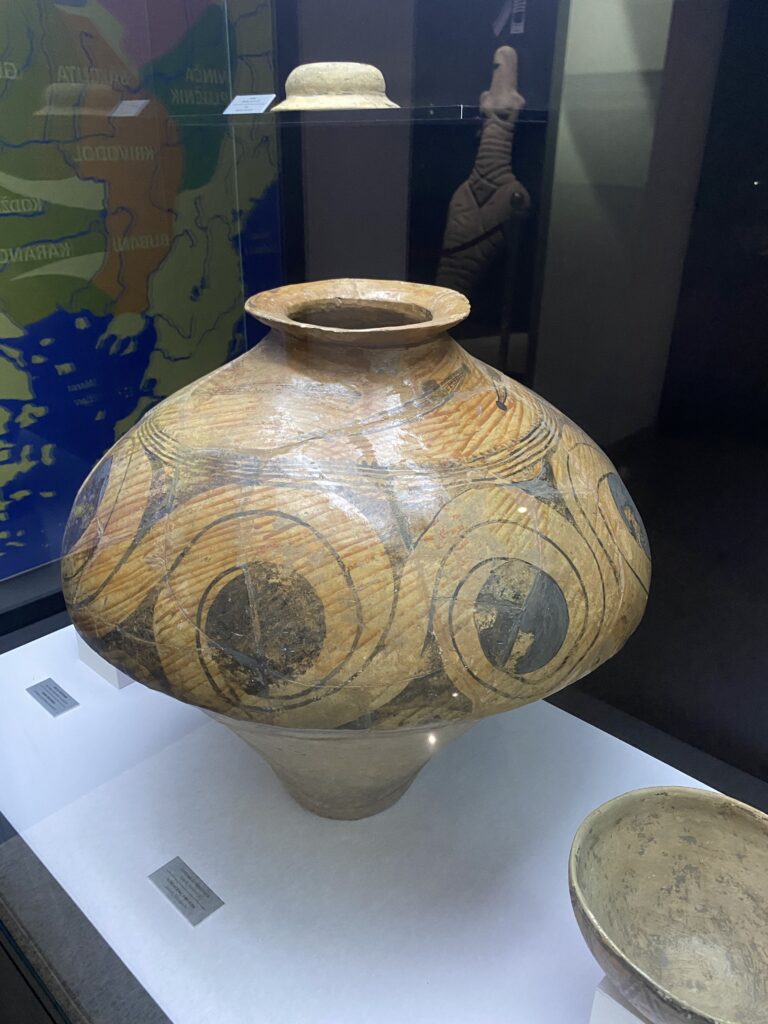
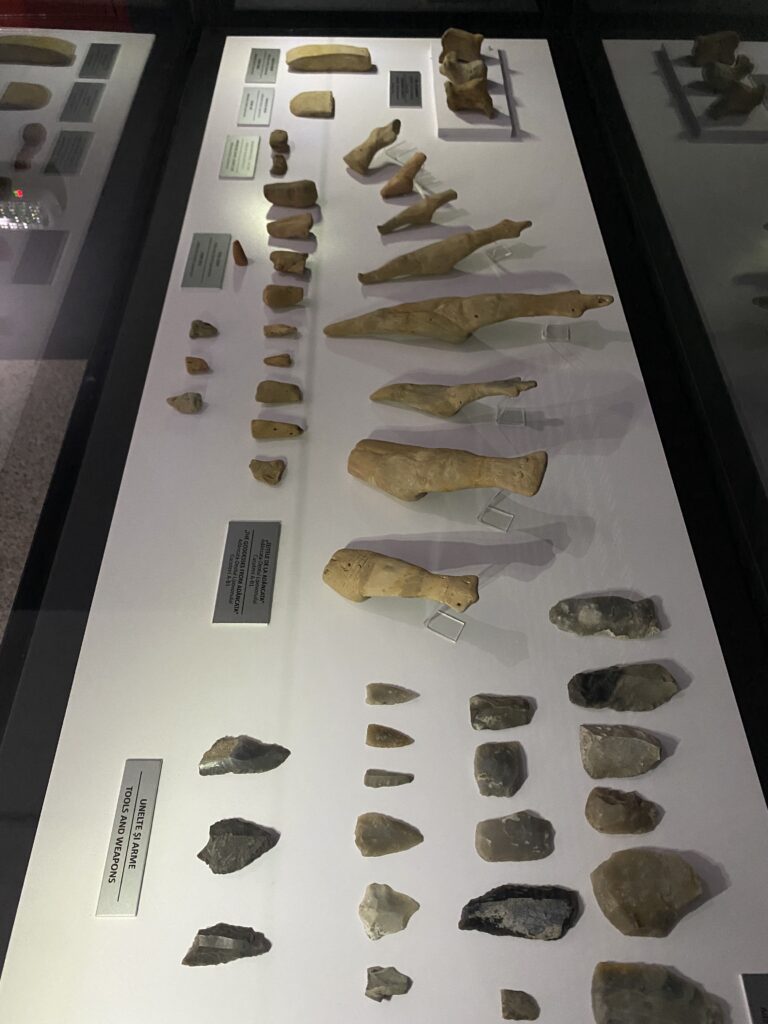
With Burned House Horizon, we have formulated ways to relate to this ancient civilisation as a collective of queer, gender non-conforming artists from various diasporic and migrant origins, who could draw learning and inspiration from the traces of the past. For instance, we noted that these ‘goddesses’ did not represent female versions of ‘god’, but non-binary cosmic principles of creation; or that, by looking at the concentric tree ring-shaped settlements of Cucuteni-Trypillia and their artefacts, such an extensive civilisation existed for thousands of years in relative peace, without the use of warfare; and that their house-burning practice might have been related to intentional rituals of renewal and regeneration rather than being the result of traumatic events.
Although situated in the past and in a defined area of Eastern Europe, with Burned House Horizon we expanded our temporal and geographical horizon to speak, via ancestral connections, of the condition of many trans and queer people living in the present time. It was specifically Byuka’s personal experiences that first grounded the concept of Burned House Horizon: from processing the trauma of growing up in a homo-transphobic society (in a post-Soviet industrialised medieval town close to the borders of Ukraine and Moldova) to their migrating to the UK, where they witnessed a fire that set ablaze their home and belongings.
“Fire the talisman we can activate anytime –
Fire the home maker, enchanting, feeding, warming
do you dream of home?
A home that is not yet here?”
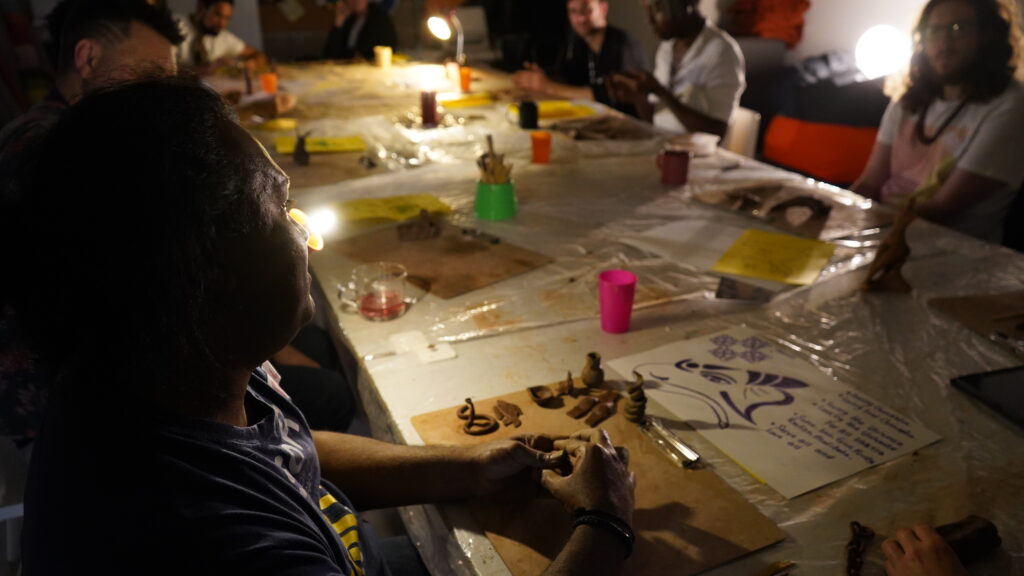
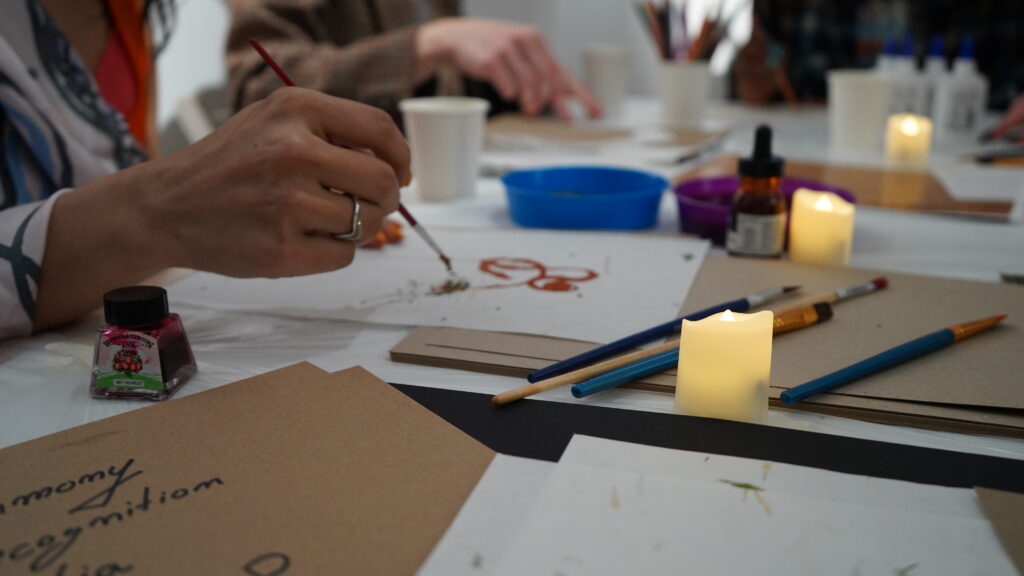
Burned House Horizon has therefore been exploring the themes of migration (forced or voluntary), homelessness and home-making through the healing powers of speculative fiction and ancestral connection. We invited a group of artists of diverse migrant origins and partnered with the Central East Asian and Eastern European communities of United Queerdom (many of whom are also refugees), and the queer (mostly of colour) homeless communities of The Outside Project. These communities, together with a more ‘generic’ LGBTQI+ group, participated in our ritual workshops and, through visualisations and embodiment exercises, created the queer deities that became part of the final exhibition—carefully integrated into Alex Hincapié’s earth & clay installation ‘Leña Quebrada’ (meaning ‘broken fire’), which paid homage to the collective, warm spirit of bonfire nights. Alex’s work attentively connected the diversity of the clay figurines in the space with the broken flames of their installation, and a fire altar where beeswax candles were regularly lit. Through our encounters with clay and other organic materials, the exhibition became our channel to process trauma through artistic creation and community rituals.
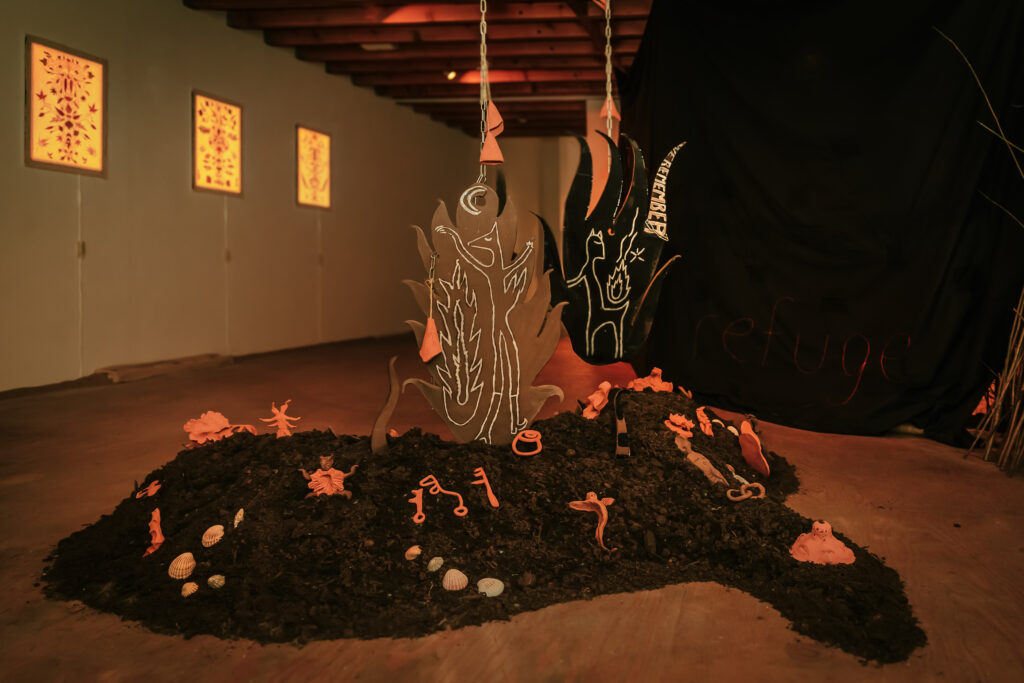
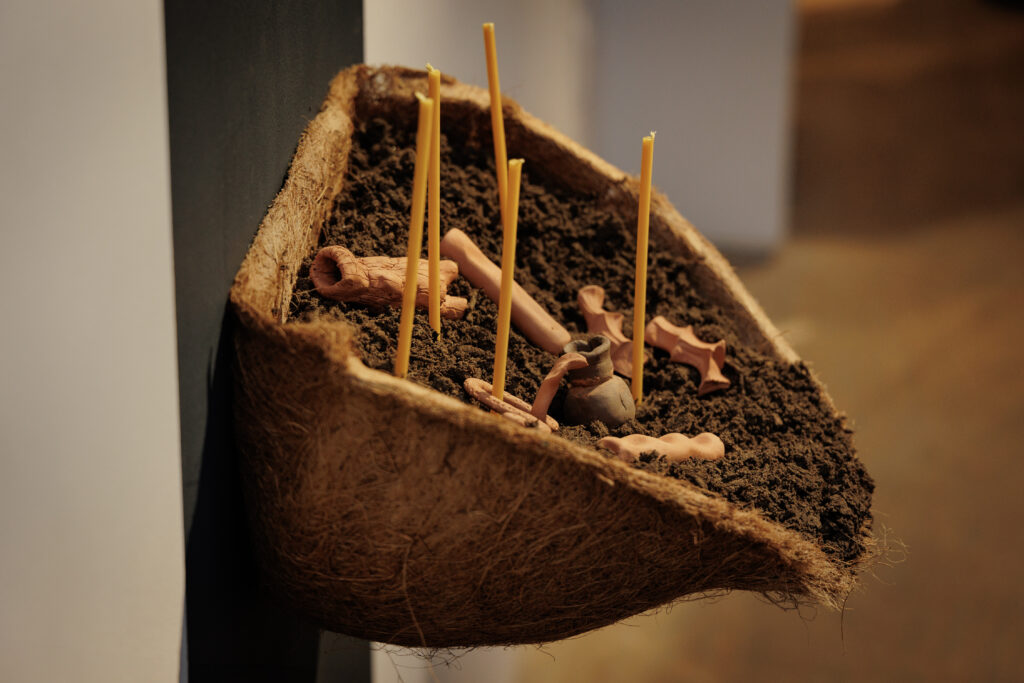
It is Saturday night, and we are in Wirral, on the hills near Liverpool. Bidston Observatory is at our backs and some faint, but constant, rain starts falling, as we prepare a bonfire in the parking lot. The crackling flames grow as we mould terracotta figurines whilst telling each other stories of past nightmares and future dreams… The rain persists, but the flame does not cease to burn, so we place our sculptures within it—slowly watching them come alive.
Fire and earth have been ever-present in Burned House Horizon. The energies and spirits of these elements have allowed us to travel across time and space, connecting diverse practices, people and territories in a cohesive vision of the ancestral future we created. The invitation was to see ourselves as already ancestors—or, ‘future ancestors’. As such, what traces do we leave behind for future generations? What responsibility do we have towards our present time? The exhibition acted as a ‘time capsule’ in which the audience was invited to see the present as if it was the past, by discovering an archaeological site of sorts within the wooden architecture of Mimosa House, with artefacts emerging from soil, clay, tree branches and sand.
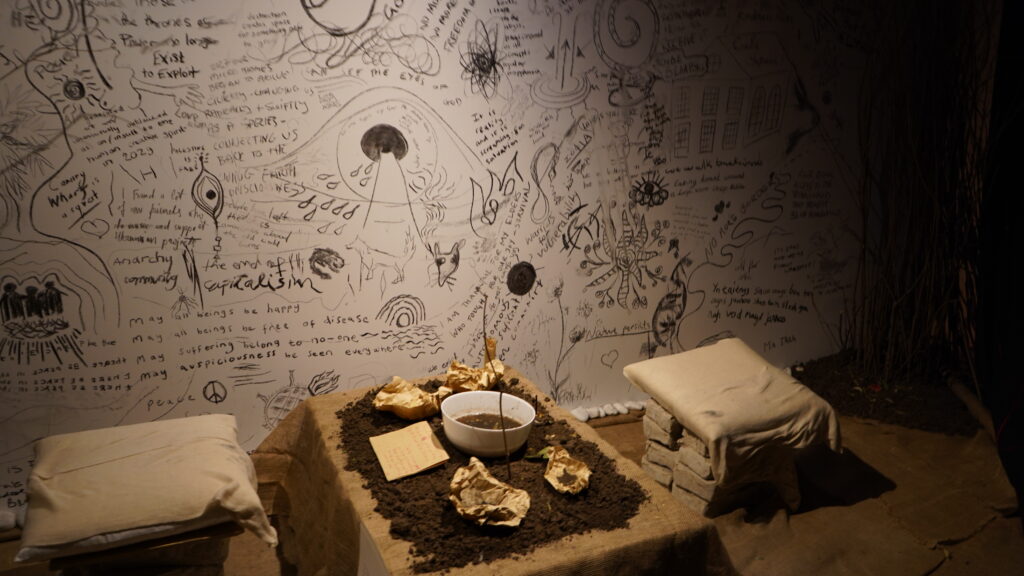

More tangibly, the visitors were also invited to imagine this speculative future scenario by engaging in the installation and one-to-one performances devised by Vlada Vazheyevskyy, also known artistically as V(A). In ‘A space → place of refuge’, Vlada led us into an exercise of future archiving, asking us to see ourselves in 20 years’ time, and to leave the traces of that encounter on the gallery walls, using black charcoal. She also invited us to intentionally leave an object inside the pockets of the curtain that divided the space, in exchange for a ‘protective pouch’ made with soil and herbs from her mother’s garden in Ukraine (where, nearby, a Russian missile hit the grounds). About a month before the opening of the exhibition, the two met in Poland, where they also exchanged those items that so powerfully charged the space in an exercise of cross-border refuge and resistance.
It is almost 10pm at Mimosa House. It is the last Sunday of the exhibition, and I have stayed behind to photograph what the visitors have left in Vlada’s ‘tent’… I find offerings of all sorts—from travel cards to candies, petals, a book, a broken pomegranate, and even a sock! The charcoal writings are overspilling—becoming part of an eerie forest of texts, drawings and symbols. Voices from the future are telling me: “We are not strangers”, “In 2035 a world REVOLUTION set the foundation of the KINDNESS COMMUNITY no blood was spilt”, “We found ancient seeds… and sowed them to replace the 3rd printed forests”, “May we hospice modernity with the gentleness & bravery it will take to the heal with care”, “… queer eco-village rituals & art with the land & loved ones”, “Power no longer exists to exploit”, “Global Arts Fund against climate change & wars”, “I am thankful for my elders who fought for our joy & survival”, “Palestine is free”…
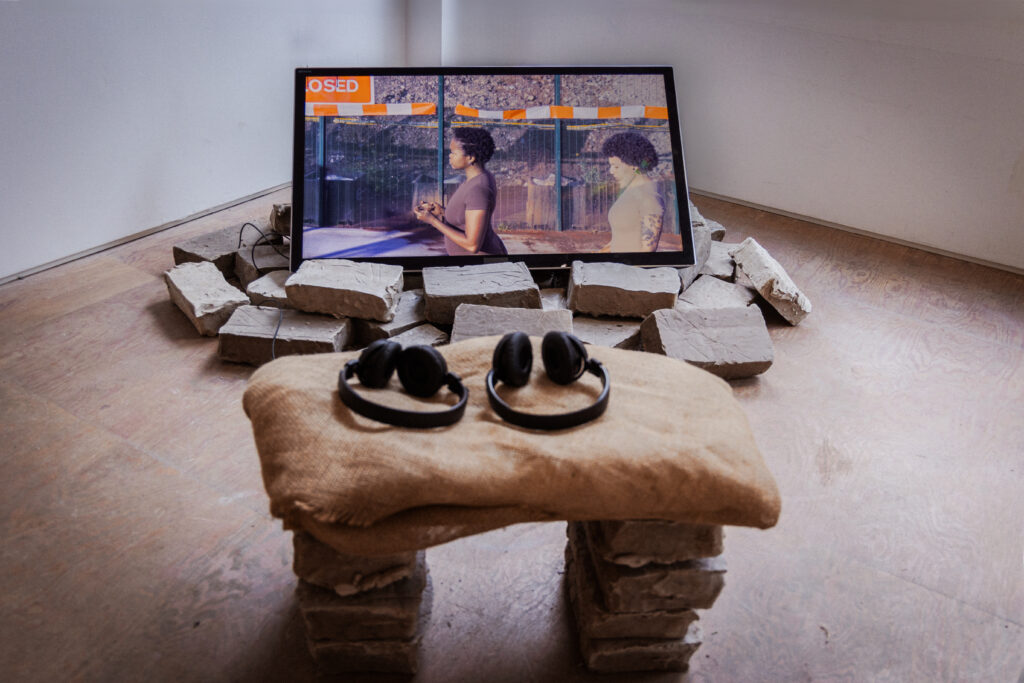
What if land, instead of being the reason for conflicts, became the tool of our liberation? In ‘Embrace’, n:u and Sym Stellium pour soil and Palestinian olive oil onto their black bodies in a wrestling ritual that finally becomes a tight embrace—-the play between tension and tenderness, power and intimacy leaving a deep resonance in the space, just as we step from the street into the archaeological space of the exhibition.
“bell hooks tells us the origin of the future
Is in the choice of love
Like how witches were praying to the earth
While their skins melted,
Abolitionist prayers
Blooming from their mouths”
My guide says “The whole of the Bidston area shows sandstone deposited some 206 – 248 million years ago in the Triassic period when the land was a scorching desert…” I can see that from the quality of the land we are walking on—made of grainy rocks that are prone to be eroded or carved. Probably the most ancient carving around here is the 9th century-old ‘Sun Goddess’, representing a stylised figure in a crucified position, with a sun under her feet. I finally find her, and call everyone to gather around and pay homage to the Sun-fire that will illuminate our artistic journey. Looking around me, I notice a small, shiny, pendant earring dangling from the nearby tree, and a whole candy inside the goddess’ sculpted vagina.
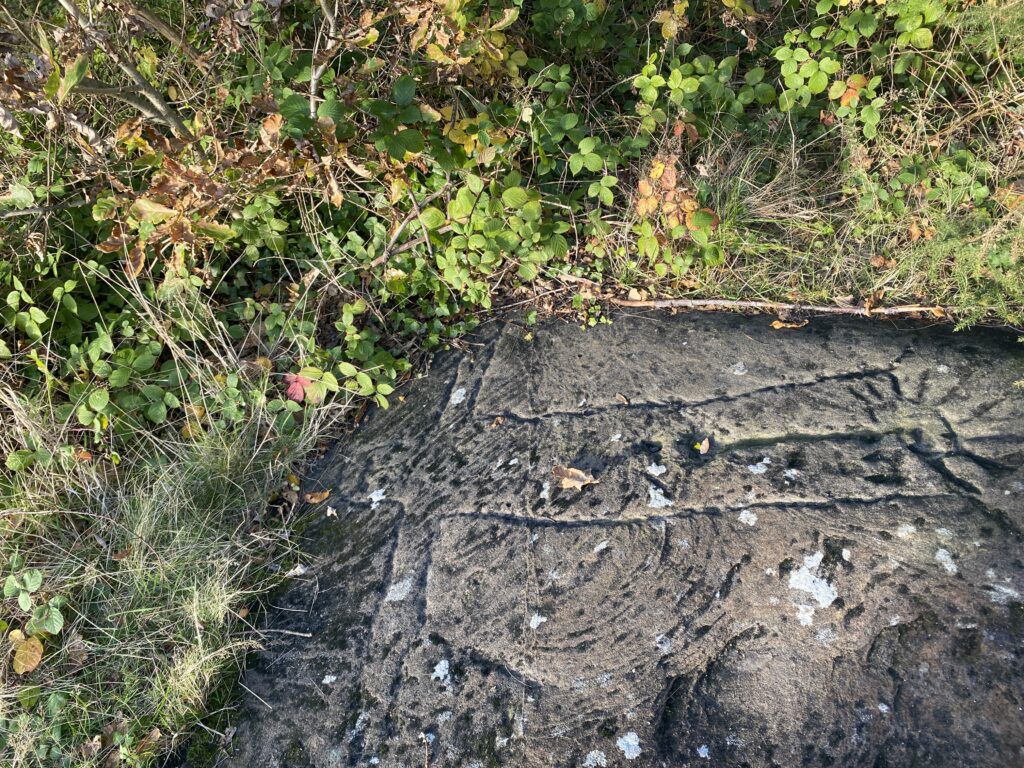
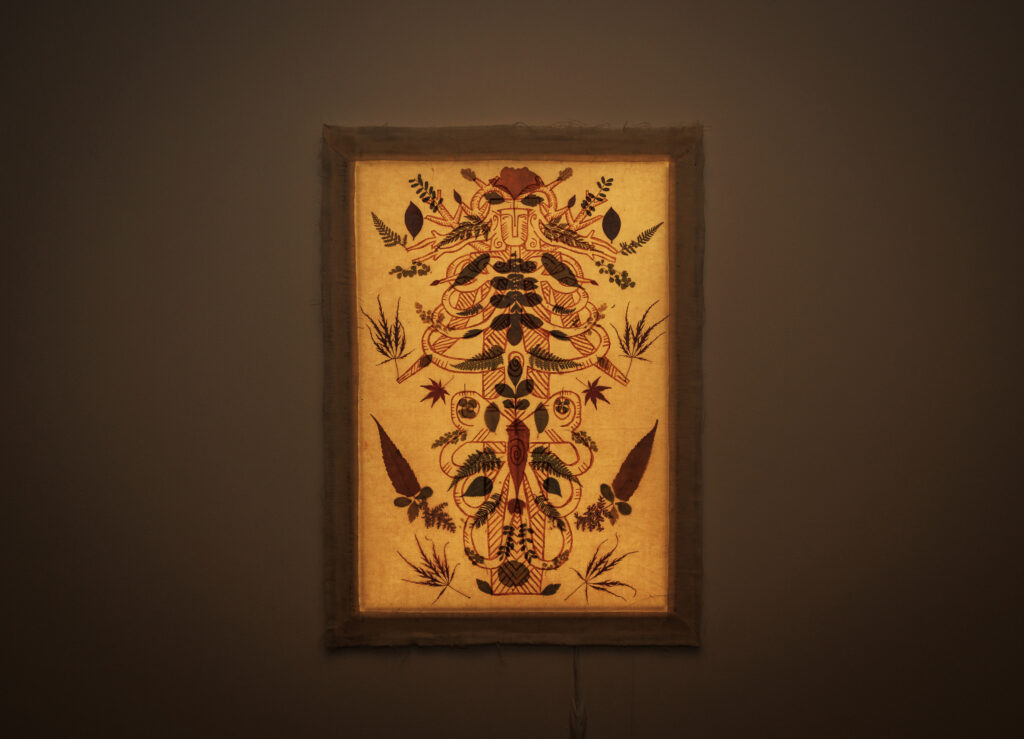
Ayshe-Mira Yashin’s ‘Earth-Body Goddess Exoskeletons’ homages the divine within the Earth we live in and are made of—the earth-as-soil-as-clay-as-sand-as-stones that has been accompanying us since immemorable times. Our bodies are made of this matter, and everything around us is an extension of it. The four goddesses made with pressed leaves and menstrual blood that glow from within the four lightboxes are a reminder of this sacred, primordial connection.
“The chronobiology placing our bodies
Into earth-time attunement
Equinoxes and solstices
Moulding your heart into an instrument
Played by solar deities…”
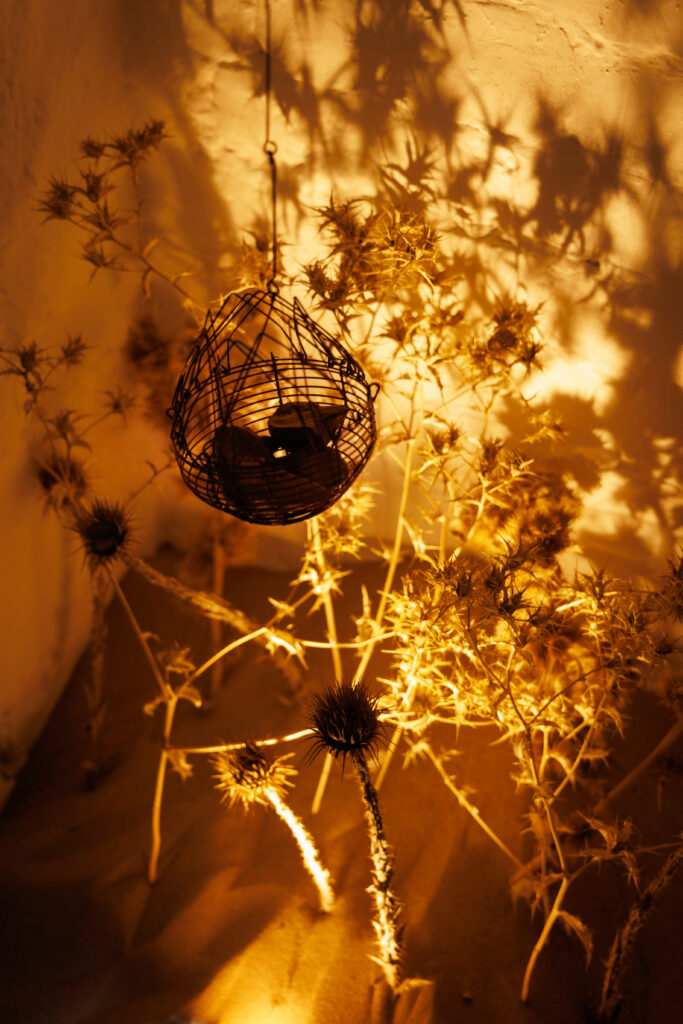
In ‘preserve the light’, Gisou Golshani has flooded the exhibition space with a hauntingly soothing soundscape made of low frequencies intertwined with chants, prayers and a crackling fire. For this, the artist has travelled physically and conceptually to her homeland in Iran—then coming back to the UK with the dried thorny flowers of a perennial plant that she encountered whilst hiking around the mountains of Tehran. Allegedly, it was when a Persian king threw a stone towards a snake that fire was ‘birthed’—the spark caused by the collision with another stone lighting up a nearby bush. Gisou brings this myth (without its heroes) to the heart of Mimosa House, where its original fireplace used to be. Covered in sand, this boundary-crossing fireplace also speaks of fire as the sparkle of the revolution, which the artist keeps on carrying within her, and her sonic activism.
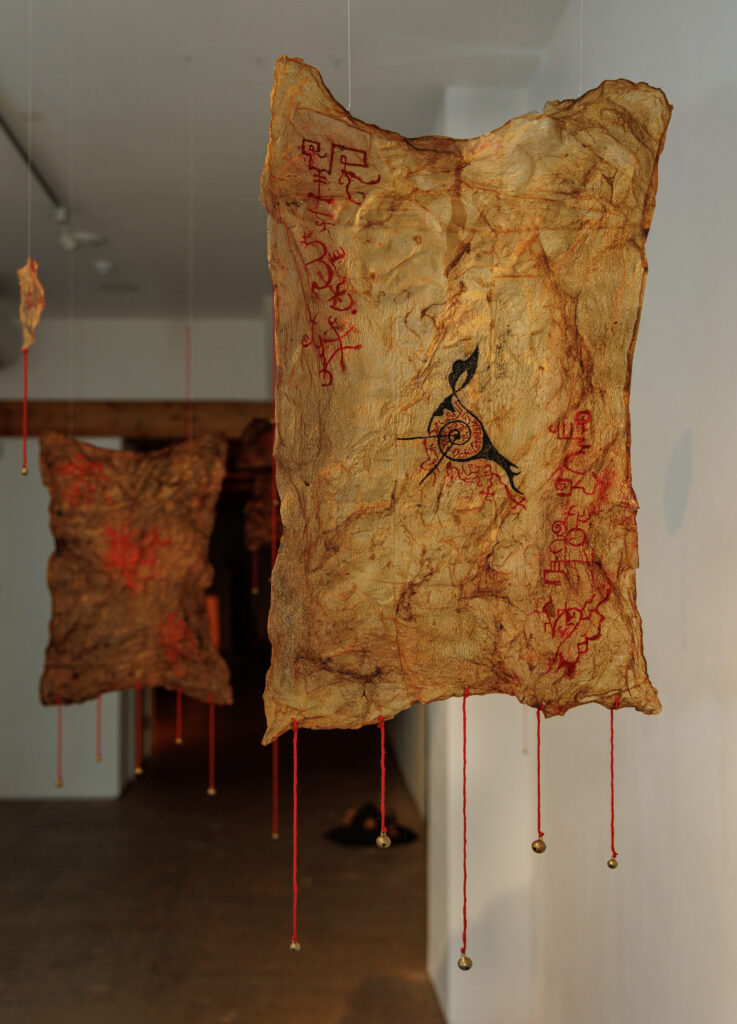
Back at the entrance of Burned House Horizon, Byuka’s artwork ‘The Oracles of Ancestral Futures’ are floating scrolls made of biomaterial – dried Kombucha leather. Using tattoo and divination, Byuka transcribed in symbolic forms the language of the land: ‘The Oracle of Queer Temporality’, ‘The Oracle of Home-making’ and ‘The Oracle of Creative Fertility’ are sigils that correspond to specific spells and poetry.
“What I pray for has its own physiology
A breath of heavier gravity
invited in the lower belly
A new choreography my nervous system learns doing
Expanded muscles soft
To receive new stories:
Now
Your heart is a blood chamber
homing neolithic horses
Galloping towards
Solar punk futures”
This is what the Oracle of Creative Fertility told me—the card I picked out of the seven that Byuka created for Burned House Horizon. As I sip a ‘tea potion’ made with Romanian herbs for the exhibition, I travel back in time and space, on the border-crossing Rarău Massif, where I listened to these same words in the form of a recited poem for the first time. There, I started sensing with my body the spiralling flows of history. There, we saw the waxing moon in the sky and danced to it the same way our ancestors did.
Giulia Casalini (she/they) is a freelance curator-artist-researcher and transfeminist organiser based in London. They hold a PhD from the University of Roehampton (Technē-funded), where they analysed queer-trans-feminist live art from transnational, anti-colonial perspectives. They have been co-founder and artistic director of the non-profit arts organisation Arts Feminism Queer (aka CUNTemporary, 2012-21), and of Archivio Queer Italia (2014-17). Giulia sits on the advisory board of Mimosa House (London) and is a Live Art Associate UK. Their (eco)transfeminist and queer activism aims to build and bridge communities across the globe through the arts and (nature)cultures. They are currently reflecting on how healing should be rooted in curating through well-being and spiritual practices. They do so through ongoing practices of noticing and unlearning colonial patterns in knowledge-making, work praxis, social relationality and institutional logic.
Byuka aka Fortune Tailed Beast (they/them) is a migrant performance artist & witch, playing at the intersections of poetry, dance, film and tattooing. Their work explores folk futurism and practices of queer-animist world-building through community rituals, speculative fiction, embodied ecologies & ancestral healing. Their work has been shown at the Royal Albert Hall, Iklektik, Camden’s People Theatre, the National Gallery, Barbican, Guildhall, Ugly Duck and Mimosa House. They have been featured in the series ‘Witch’ on BBC Sounds.
Credits: If not otherwise indicated, all photos are by the author.